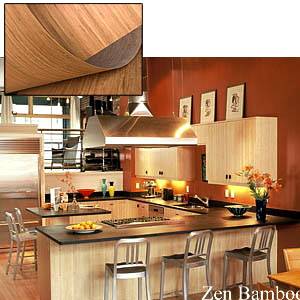|
| |

Uses:
Canyon Peak manufactures furniture grade bamboo veneer for
interior applications. Intended uses: cabinetry, furniture, interior paneling,
wall treatments and any other interior application where veneer wood products
are needed to be used.
Recommendations for Storage and Handling:
The following basic steps in handling and storage
are recommended to help avoid or minimize some of the problems associated with
wood movement.
-
Veneer should be stored flat.
-
Humidity and temperature controls that are
capable of maintaining a constant 40 to 60% relative humidity and 65 to 75°F
should be installed.
-
Extreme heat or coldness should be avoided.
-
Veneer stored in an uncontrolled environment
should be brought into the fabrication area 24 to 48 hours prior to being
processed. Evenly distributed weight of the stack will help the veneer
acclimate uniformly.
-
All exposed veneer surfaces should be sealed.
-
Allowance for linear expansion should be
incorporated into the design of the product.
-
Veneer should not be taken to a job site until
the site is completely ready for the product to be installed. It should be
allowed to acclimate to the job site before installation.
-
Veneer should not be installed over wet or
unfinished drywall.
-
The finished product should not be installed
until after it has been heated, ventilated, and cooled.
Finishes & Adhesives:
Independent testing was performed to ensure that the
adhesive between the bamboo slats is compatible with methyl alcohol and methyl
ethyl ketone-based products. The adhesive used in the back of our
1/42” paper-fleece backing meets specifications as a D-4 waterproof glue. Veneer
must be bonded to a suitable substrate of a reliable quality. MDF (medium
density fiberboard) is the most stable substrate, followed by industrial
particleboard, veneer-core plywood, and the least stable substrate is hardwood.
We do not recommend direct application to drywall, plaster walls, concrete walls
or cardboard products, as delaminating may occur. Veneer should be applied to
MDF substrate to cover these surfaces. Installation over substrates that have
been treated with a fire-retardant agent is not recommended. If using a hot
press method to laminate veneer, the best temperature is at 120° celsius. When
applying finishes, avoid over-saturation of the veneer surface. Follow
manufacturer’s suggested temperature and thickness for application. We recommend
testing the adhesive or finish you wish to use to ensure the overall
compatibility between the treatment, the veneer, and the installed environment.
Please note that the adhesive used to manufacture the veneer is not food grade.
If the surface is to be used for food preparation, a food grade sealer is
recommended.
Due to varying application environments and situations, these
guidelines do not guarantee results and should be used as a supplemental source
of information only. For more information about relative humidity and its
relationship to moisture content, please reference the Architectural Woodwork
Institute (AWI) web site at
www.awinet.org and the Hardwood Plywood and
Veneer Association (HPVA) website at www.hpva.org.
|
![]() Gardeners' Corner
Kids'
Garden
Sustainable Garden
Go
Shopping
Gardeners' Corner
Kids'
Garden
Sustainable Garden
Go
Shopping![]()

